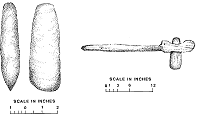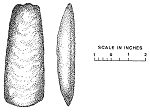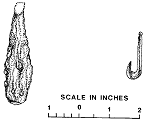Before the Europeans came to North America, the Iroquois made tools from stone, bone, and antlers.
 Figure 6. A stone axe
Figure 6. A stone axe
The two views of the axe head show its edge and its flat face. Notice how the axe tapers toward the top, away from the cutting
edge. The handle has a hole through it that fits over the narrow end of the head. When the axe strikes a log, this forces the taper
into the hole, which keeps the axe head tight in the handle.
An axe head was made from a hard stone by grinding and polishing it with other stones until it had the right shape and a sharp edge. A handle was then fastened to the axe head to complete the tool, which could be used to chop down trees, trim off limbs, cut logs to a desired length, and roughly shape the logs.
 Figure 7. A stone adz
Figure 7. A stone adz
The two views show the flat face and the edge view. Notice that in the edge view, the adz is not symmetrical. It is nearly flat on
one side and curved on the other. A tool with this shape is good for paring off rough surfaces. The handle would extend to the
right from the edge view.
The Iroquois made an adz in the same way, and used this tool to smooth bark or shape a log. (An adz is similar to an axe in that it has a heavy head and a handle, but it is shaped like a hoe, and in use is swung like one.)
 Figure 8. Fire as a woodworking tool
Figure 8. Fire as a woodworking tool
Fire was used to help fell the tree. The woman is using it to help cut the log to length.
Fire was another woodworking tool commonly used by the Iroquois. Small controlled fires were used to fell trees and cut posts and poles to length. As the fire burned into the wood, the charred parts were scraped or chopped away with a stone tool to control the position of the cut. A large log can be shaped into a canoe with the same method. Using fire to help cut down a tree was much easier than using a stone axe alone. Fire also was used to char the ends of posts before they were set into the ground. Charring slowed down the rotting that attacks buried wood, and made the posts last longer.
 Figure 9. A knife blade and an arrow point made of flint
Figure 9. A knife blade and an arrow point made of flint
A knife blade and an arrow point made of flint
The scalloped surfaces on the tools show where small bits of flint were flaked off the stones to shape them and form the sharp
edges.
The Iroquois made knife blades and arrow points from pieces of flint. Flint is a type of stone that can be chipped to a sharp edge. The flint blades were then fitted with handles, and the knives were used for a variety of cutting jobs. The arrow points were attached to straight sticks to make a sharp arrow. Drills, scrapers and other tools were made of flint as well.
The Iroquois were also known for their skill at making tools from bone and antlers. The natural shape of the raw material was important in the design of these tools.
 Figure 10. Bone tools used for piercing leather or bark
Figure 10. Bone tools used for piercing leather or bark
Figure 10 shows two sharp pointed awls and a knife made from bone.
 Figure 11. Bone arrow points
Figure 11. Bone arrow points
Notice that the arrow shaft could be slipped into the natural hollow of the bone.
Figure 11 shows three bone arrow points.
 Figure 12. A chisel made from a deer antler and a fish hook made from bone.
Figure 12. A chisel made from a deer antler and a fish hook made from bone.
A chisel could be made from a long piece of bone or antler. The end of the tool was ground to a sharp edge. The chisel was used to peel bark from logs, poles or standing trees. Long chisels can be pushed with both hands and perhaps with the shoulder as well.
The Iroquois made digging sticks by sharpening the end of a wooden pole. They used these to loosen the soil where the posts for the longhouses were to go. Perhaps they made shovels from long wide bones or antlers to lift the dirt from the holes.
- adz
- A tool somewhat like an axe, with a short handle attached so that the tool
resembles a hoe. It is used for trimming and smoothing wood or bark.
- awl
- A small pointed tool used to punch holes in bark or leather.
- archeologist
- A person who studies people who lived long ago by excavating their tools
and weapons, and other buried evidence of the way they lived.
- charring
- To partly burn, scorch. Charcoal is a result of this process.
- chisel
- A long tool having a strong blade with a sharp edge at one end for cutting
or shaping wood or stone.
- clan
- A group of families who have a common ancestor. All the people in an
Iroquois clan traced their heritage through their female ancestors: from
their mother to her mother, to her mother?s mother, and so on back to the
original woman who started the clan. The Bear, Wolf, and Turtle clans
were common to all of the Iroquois.
- extended family
- A number of family units, (mother, father and children) who are related to
each other. An extended family includes grandparents, aunts, uncles and
cousins, and their immediate families.
- flint
- A very hard stone that will chip to a sharp edge. It is a kind of quartz.
- grid pattern
- A pattern of evenly spaced vertical and horizontal lines.
- palisade
- A fence made with poles or posts set in the ground to stand upright, built
as a barrier for defense against enemies.
- pole
- A long slender log from a small straight tree. Poles are connected to the
posts in the longhouse to complete the framework.
- post
- A strong, stiff log that was placed upright in the ground as support for the
longhouse framework.
- rafters
- Any of the sloping poles used to hold up the roof.